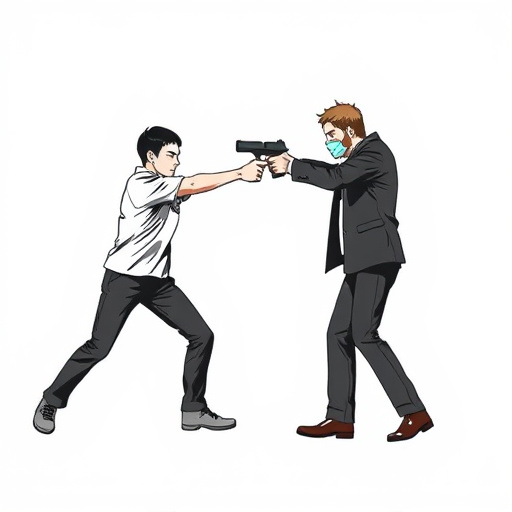Pepper spray, a non-lethal self-defense tool, uses capsaicin (oleoresin capsicum) to cause temporary incapacitation through intense burning sensations. Its effectiveness varies with concentration, weather, and individual sensitivity, lasting 3-15 minutes. Civilian-grade sprays, popular for personal safety, have lower OC concentrations than law enforcement versions, but understanding variability in effects and local laws is crucial for responsible use. Mastering application technique, storing safely, and adhering to legal guidelines are key to maximizing its potency as a last resort defense option.
“Uncover the power and potential pitfalls of civilian-grade pepper defense spray. This comprehensive guide delves into the intricate world of self-defense, exploring its composition, mechanism of action, and surprising longevity—up to 45 minutes or longer, depending on factors discussed. From understanding legal considerations to mastering application techniques, we equip you with knowledge to make informed decisions about this controversial yet potent tool. Learn how to deploy it safely and effectively, weighing the benefits against the risks.”
- Understanding Pepper Spray: Composition and Mechanism of Action
- Factors Influencing the Duration of Pepper Spray Effects
- Civilian Use and Legal Considerations
- Effective Application Techniques and Safety Precautions
Understanding Pepper Spray: Composition and Mechanism of Action
Pepper spray, also known as oleoresin capsicum (OC) spray, is a non-lethal self-defense tool that uses capsaicin, the active compound found in chili peppers. When deployed, pepper spray creates a temporary incapacitation by provoking a painful, burning sensation in the eyes and respiratory system. The composition typically includes OC, a solvent, and various additives to enhance performance and longevity.
The mechanism of action involves the spray’s chemical interaction with nerve endings, specifically those responsible for pain and inflammation. Capsaicin binds to these receptors, leading to an intense irritation response. The effect lasts for approximately 3-15 minutes, depending on factors like concentration, weather conditions, and individual sensitivity. Understanding the duration and composition of pepper spray is crucial in choosing the right self-defense option, ensuring its effectiveness when needed.
Factors Influencing the Duration of Pepper Spray Effects
The duration of pepper spray effects can vary widely depending on several factors. One primary consideration is the concentration of capsaicin, the active ingredient responsible for the burning sensation and irritation. Higher concentrations typically result in longer-lasting effects, often ranging from 20 minutes to an hour or more. However, commercial-grade pepper sprays designed for civilian use usually have lower concentrations tailored for safety and legality, leading to shorter durations of around 10 to 30 minutes.
Other influential factors include the target’s fitness level, body mass, and overall health. Fitter individuals may experience a quicker breakdown of the spray’s effects due to improved circulation and organ function. Environmental conditions also play a role; cold temperatures can prolong the sensation, while hot and humid weather might reduce its impact faster. Additionally, the method of application affects duration; direct spraying onto the eyes typically has more immediate and intense effects than spraying clothing or skin, where absorption and diffusion occur over time.
Civilian Use and Legal Considerations
Civilian grade pepper defense spray has gained popularity among everyday people for personal safety, especially in situations where self-defense is necessary. Unlike law enforcement or military-grade options, civilian pepper spray is designed to be accessible and easier to use by the general public. However, its widespread adoption also raises important legal considerations.
The effects of pepper spray, also known as oleoresin capsicum (OC), can last for several minutes, impairing an attacker’s vision and breathing. How long these effects persist varies depending on factors like the concentration of OC, the size of the dose deployed, and individual sensitivity. While it offers a crucial window of opportunity for victims to escape or seek help, it’s essential to understand that its legality differs across jurisdictions. Some areas have strict rules regarding who can possess and use pepper spray, while others may have minimal restrictions. Knowing local laws is paramount to avoid legal repercussions and ensure responsible usage.
Effective Application Techniques and Safety Precautions
Effective application techniques are key when using civilian-grade pepper defense spray. To maximize its effectiveness, aim for the face and eyes, as pepper spray is most potent in these areas. Use a quick, sharp motion to spray directly into the attacker’s face, ensuring you maintain distance for your own safety. A good technique involves a short burst of 2-3 seconds, allowing the spray to settle on the target before moving away or seeking cover. Practice makes perfect; familiarizing yourself with the spray’s range and pattern will improve your response time during an actual emergency.
Safety precautions are paramount when carrying pepper spray. Always store it in a secure location, out of reach of children or unauthorized individuals. Regularly review safety guidelines, understanding that incorrect use could have adverse effects on individuals with respiratory conditions or other health issues. Be aware of local laws and regulations regarding the carry and use of pepper spray, as these vary by region. Additionally, ensure proper disposal methods are followed to prevent environmental contamination, considering pepper spray’s potential impact on wildlife and water sources. Remember, while pepper spray can provide a crucial layer of personal defense, it should be used as a last resort when facing an imminent threat.
Pepper spray, a powerful personal defense tool, has proven its effectiveness in deterring assailants. Understanding its composition, mechanism of action, and the factors influencing its duration is key to maximizing its utility. For civilians considering pepper spray for self-defense, navigating legal considerations and learning proper application techniques are essential. By following safety precautions and knowing how long pepper spray effects last, individuals can gain a valuable layer of protection in today’s diverse and sometimes unpredictable world.
